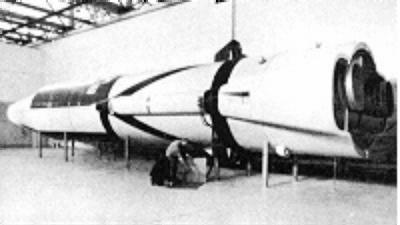
Home - Search - Browse - Alphabetic Index: 0- 1- 2- 3- 4- 5- 6- 7- 8- 9
A- B- C- D- E- F- G- H- I- J- K- L- M- N- O- P- Q- R- S- T- U- V- W- X- Y- Z
Contracted Atlas

WS-107
WS-107 Concept 2. First mock-up of the Atlas missile in the three-chamber configuration.
Credit: Ronald Wade
Status: Design 1954. Payload: 1,360 kg (2,990 lb). Thrust: 725.00 kN (162,986 lbf). Gross mass: 109,000 kg (240,000 lb). Height: 23.00 m (75.00 ft). Diameter: 3.05 m (10.00 ft).
Maximum range: 10,200 km (6,300 mi). CEP: 3.70 km (2.20 mi).
Family: orbital launch vehicle. Country: USA. Agency: Convair.
1953 October - . LV Family: Atlas. Launch Vehicle: Contracted Atlas.
- Teapot Committee's first output - . Nation: USA. ICBM could use smaller warhead.
1954 March - . LV Family: Atlas. Launch Vehicle: Contracted Atlas.
- US tests confirm feasibility of small thermonuclear warheads - .
Nation: USA.
The United States exploded its first "droppable" hydrogen bomb in the Marshall Islands. A second U.S. thermonuclear device was successfully tested on 20 March. These tests as part of Operation Castle confirmed the feasibility of the development of lightweight, high-yield thermonuclear weapons. This advance allowed the previously restrictive performance characteristics of the Atlas to be relaxed to the point where continued development was within the existing "state-of-the-art."
Back to top of page
Home - Search - Browse - Alphabetic Index: 0- 1- 2- 3- 4- 5- 6- 7- 8- 9
A- B- C- D- E- F- G- H- I- J- K- L- M- N- O- P- Q- R- S- T- U- V- W- X- Y- Z
© 1997-2019 Mark Wade - Contact
© / Conditions for Use